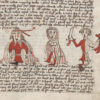…hoc est: ars per occultam scripturam animi sui voluntatem absentibus aperiendi certa: praefixa est sua clavis, seu vera introductio ab ipso authore concinnata nunc publici juris facta
by Johannes Trithemius, Frankfurt: 1606
Steganographia is Johannes Trithemius’ most notorious work. Many today consider it a work of cryptology with a system of angel magic only at its surface. However, It need not one or the other. It is equal parts magic and cryptography that together form a highly sophisticated system of angel magic. The preface to his Polygraphia equally establishes this notion that cryptography was conceived by Trithemius as a “secular consequent of the ability of a soul specially empowered by God to reach, by magical means, from earth to Heaven.”
“The practicability of cryptography is secular consequent of the ability of a soul specially empowered by God to reach, by magical means, from earth to Heaven”.
Trithemius
Trithemius, mentor to Henrich Cornelius Agrippa & Paracelsus, wrote his Steganographia in 1499 which circulated in manuscript form for many years. In a limited release, it received such reactions of fear that Trithemius decided it should never be published. He apparently removed the more extreme portions which might explain why the “Spirit Compass Rose” is only partially filled in the printed edition (See Lemegeton Clavicula Salomonis #2 for further detail). It was eventually published posthumously in 1606 at which time it was instantly placed onto the Index librorum prohibitorum. Some scholars consider Steganographia to be Part 1 of his later work, Polygraphia, but it is more likely that Polygraphia was a revision of his Steganographia to minimize controversy.
Trithemius mentions Sepher Raziel as one of his sources when writing Steganographia. In 1508 (published 1605) he wrote a a book on counter magic in an attempt to create a “theologica magica,” a category of magic that was compatible with the liturgy of the Catholic Church. It is also included a bibliography of necromantic texts called, Antipalus Maleficiorum. Amongst them is an entry for Sepher Razielis and many others that he likely consulted for his Steganographia.
In turn, fragments from Steganographia can be found in countless grimoires from the 16th century onwards. Most notably is the Ars Theurgia-Goetia which is apparently a refactoring of Steganographia with the addition of more spirit seals, rituals, and more traditional conjurations.




